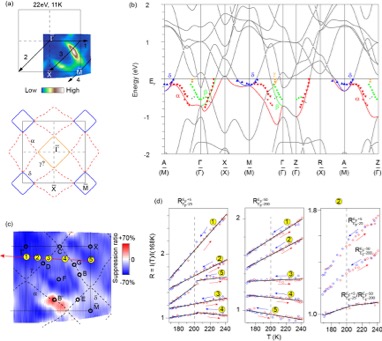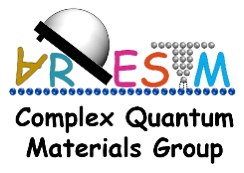Measurement of an enhanced superconducting phase and a pronounced anisotropy of the energy gap of a strained FeSe single layer in FeSe/Nb:SrTiO3/KTaO3 heterostructures using photoemission spectroscopy
After the milestone discovery of Fe-based superconductors with only electron Fermi surfaces (e-FeHTSs), their pairing symmetry has been a key unsolved problem in iron-based superconductor research. To count for the sign-changing but isotropic gap observed experimentally by neutron scattering and ARPES respectively, various novel pairing scenarios have been proposed. However they could not be convincingly tested so far, as the two electron pockets could not be resolved in two kinds of known e-FeHTSs, including AFe2Se2 and single-layer FeSe on STO substrate. Moreover, recent discovery of possible superconductivity over 65K in single-layer FeSe/STO and the strain-dependent SDW make it encouraging to design new kinds of e-FeHTSs by tuning the in-plane lattice.

Here we fabricated a new kind of e-FeHTS, by epitaxially growing single-layer FeSe on an artificial Nb:STO/KTaO3 heterostructure [Fig.1(a)], which expands the in-plane lattice of FeSe to an extreme high value of 3.989 Å [Fig.1(b)] while preserving the FeSe/STO interface. Its novel electronic structure and gap symmetry are unveiled by in-situ ARPES measurements. Our ARPES data indicate a gap closing at 70K [Fig.1(c)], 5K enhanced compared with FeSe on STO substrate [Fig.1(d)]. It is a record high Tc for iron-based superconductors assuming the gap is not due to Cooper pair pre-formation. Two elliptical electron Fermi surfaces are resolved at the zone corner, without detectable hybridization [Fig.1(e)]. The lifting of degeneracy is observed for the first time for an e-FeHTSs. The superconducting gap distribution is anisotropic but nodeless around the electron pockets, with minima at the crossings of the two pockets [Fig.1(f)]. It suggests novel s-wave pairing symmetry in e-HTSs, and poses strong constraints to current theories. Our experiments demonstrate that artificial interface is an effective tool to engineer the electronic structure and study superconductivity for iron based superconductors and beyond. This work has been published on Physical Review Letters 112, 107001 (2014).
Electronic structure of the BaTi2As2O parent compound of the titanium based oxypnictide superconductor
Recently, superconductivity has been discovered in Ba1−xNaxTi2Sb2O (0.0≤x≤0.33), a titanium-based oxypnictide with an anti-CuO2 type Ti2O plane and Sb above and below the center of each Ti2O square. From the structural point of view, such a lattice is an intriguing combination of both CuO2 and FeAs type of lattices; thus it may be another family of unconventional superconductors based on titanium. BaTi2As2O is an isostructural compound of the superconducting BaTi2Sb2O. It could be viewed as a parent compound of the titanium-based superconductors. A density wave transition takes place around 200 K, resembling that in the iron-based high temperature superconductors. The instability of the ordered state, such as spin fluctuation, often plays an important role in the unconventional superconductivity. Therefore, it is critical to study the electronic structure of the parent compound and reveal the nature of the density wave transition.
We investigate the electronic structure of BaTi2As2O with angle resolved photoemission spectroscopy (ARPES) and first-principle calculation. The experimental electronic structure shows multi-orbital nature and three-dimensional character, which is consistent with the calculated results [Fig. 1(a)-(b)]. An anomalous temperature-dependent spectral weight redistribution and broad lineshape indicate the incoherent nature of the spectral function. At the density-wave-like transition temperature around 200 K, a partial gap opens at the Fermi patches [Fig. 1(c)-(d)]. These findings suggest that BaTi2As2O is likely a charge density wave material in the strong interaction regime. This work has been accepted by PRB.
The ARPES data were taken at the beamline 1 and beamline 9 of Hiroshima Synchrotron Radiation Center (HiSOR), beamline 5-4 of Stanford Synchrotron Radiation Lightsource (SSRL), and Fudan University. This work is supported in part by the National Science Foundation of China, and the National Basic Research Program of China (973 Program)
